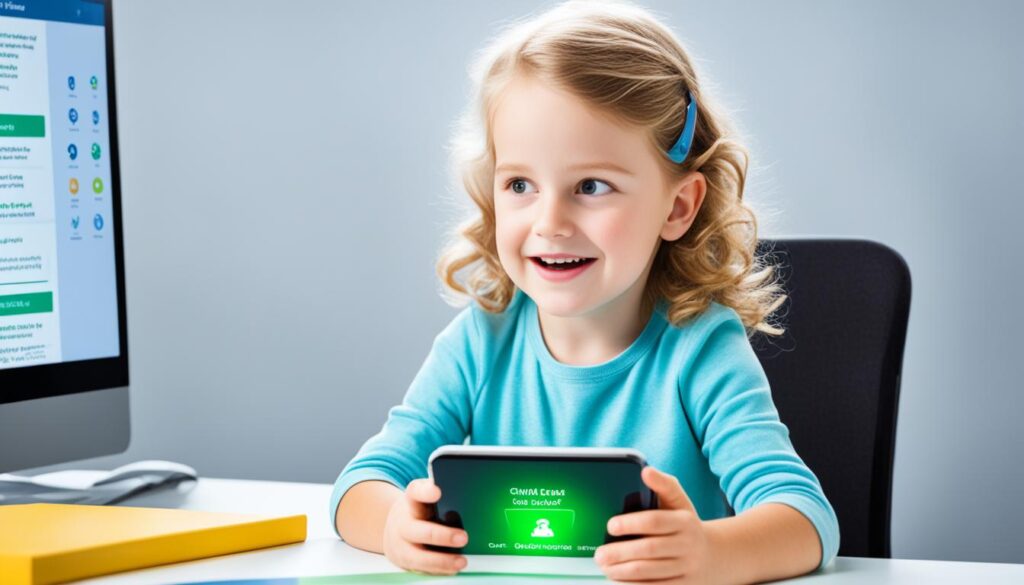Disclosure: This Post Contains Affiliate Links; We earn a commission on purchases.
Welcome to our article on fostering healthy digital habits in children. In today’s digitally connected world, it is essential for parents to promote a balance between screen time and offline activities. By following these expert tips from the American Academy of Pediatrics (AAP), you can help your children develop healthy tech habits and navigate the digital world safely.
Building a strong foundation starts with creating a family media plan. This involves establishing rules and guidelines for social media use and device usage. Setting time limits, tracking online activities, and planning regular screen-free activities are essential components of a balanced approach.
Encouraging a balance between family time and screen time is also crucial. Designating specific screen-free times and places in the home, such as during meals and bedtime, helps create boundaries. Setting do-not-disturb times and implementing media time limits further promotes offline engagement and reduces reliance on screens.
Open and honest conversations about social media are vital. By asking questions about your child’s experiences and emotions while using social media platforms, you can help them navigate the online world responsibly. These conversations also teach children to recognize inappropriate content and understand the impact of media on their emotions.
Setting a good example is paramount. Be mindful of your own social media use, and explain how you use media for positive purposes. Emphasize the importance of kindness and respectful behavior online. By modeling healthy digital habits, you can guide your children towards responsible digital citizenship.
Optimizing the online experience is another crucial aspect. Choose quality content that aligns with your family’s values and interests. Select age-appropriate platforms and establish safety rules for online interactions. By doing so, you can ensure that your children’s digital experiences are both educational and safe.
Key Takeaways:
- Build a family media plan to establish rules and guidelines for social media use.
- Promote a balance between family time and screen time by setting do-not-disturb times and planning regular screen-free activities.
- Engage in open conversations about social media to help children navigate the online world responsibly.
- Set a good example by modeling healthy digital habits and emphasizing kindness and respect online.
- Optimize the online experience by choosing quality content, age-appropriate platforms, and implementing safety measures.
Building a Family Media Plan
One important step in fostering healthy digital habits is creating a family media plan. This involves working together as a family to establish rules and guidelines for social media use and device usage. By implementing a family media plan, parents can provide structure and support for their children’s online experiences while promoting a balanced approach to technology.
“Building a family media plan allows parents to take an active role in their children’s digital lives and set healthy boundaries.”
A great resource for creating a family media plan is the American Academy of Pediatrics (AAP) Family Media Plan tool. This tool allows parents to customize rules based on their family’s preferences and values. By answering a few simple questions, parents can receive a personalized plan tailored to their specific needs.
“The Family Media Plan tool empowers parents to make informed decisions about their children’s media use based on their family’s unique circumstances.”
The key components of a family media plan include:
- Setting media time limits: Determine how much time children can spend using digital devices each day and ensure they have a healthy balance between screen time and other activities.
- Establishing social media guidelines: Decide when and how children can use social media platforms, taking into account age-appropriate options and privacy settings.
- Creating do-not-disturb times: Designate specific times during the day where devices are turned off or put away, allowing for uninterrupted family time.
- Tracking online activities: Monitor your child’s online activities and discuss any concerns or issues that may arise.
- Planning screen-free activities: Encourage regular screen-free activities that promote physical activity, creativity, and social interaction.
By following a family media plan, parents can help their children develop healthy habits around social media use while fostering a positive digital environment for the entire family.
| Benefits of a Family Media Plan | Effective Strategies |
|---|---|
| 1. Promotes a healthy balance between screen time and other activities | 1. Setting do-not-disturb times for uninterrupted family time |
| 2. Addresses concerns about social media use and online safety | 2. Establishing social media guidelines to ensure age-appropriate and safe online experiences |
| 3. Encourages open communication and dialogue about digital experiences | 3. Tracking and discussing online activities to address any concerns or issues |
| 4. Provides structure and support for children’s digital lives | 4. Planning regular screen-free activities to promote physical activity and creativity |
Balancing Family Time & Screen Time
Encouraging a balance between family time and screen time is essential for fostering healthy digital habits. By establishing specific screen-free times and places in the home, such as during meals and bedtime, families can create opportunities for quality offline interactions.
Setting do-not-disturb times on devices allows for uninterrupted family time and reduces distractions from screens. By implementing media time limits, parents can ensure that their children engage in a variety of activities and avoid excessive screen use.
Furthermore, planning regular screen-free activities that the whole family can enjoy strengthens the bond between family members and promotes creativity, physical activity, and social interaction. These activities can include outdoor games, arts and crafts, reading, or family outings.

Screen-free activities promote offline engagement and reduce reliance on screens.
| Benefits of Screen-Free Times and Activities |
|---|
| 1. Increased family bonding and communication. |
| 2. Enhances cognitive development and creativity. |
| 3. Encourages physical activity and healthy habits. |
| 4. Reduces the risk of excessive screen time and its associated negative effects. |
| 5. Provides a break from constant digital stimulation. |
Engaging in Open Conversations about Social Media
Engaging in regular, open-minded conversations with children about their social media use is crucial for fostering healthy digital habits. By initiating dialogue, parents can gain valuable insights into their child’s experiences on social media platforms, their emotions while using social media, and whether they have encountered any concerning content or interactions.
These conversations create an opportunity for parents to guide their children in understanding the complexities of the online world. Parents can discuss the difference between what is real and what is edited, helping children develop a critical eye for the content they encounter. By discussing the presence of ads and sponsored posts, parents help children recognize and navigate marketing tactics.
Moreover, open conversations allow parents to address the issue of inappropriate content. By educating children on recognizing and reporting inappropriate content, parents empower them to protect their online experiences and stay safe. Additionally, parents can help children understand the emotional impact of social media and how it can influence their mood, self-esteem, and relationships.
“Conversations about social media empower children to make informed decisions and navigate the digital world responsibly.”
It is vital for children to know that they can come to their parents with any online experiences they encounter. By fostering a culture of trust and open communication, parents can create a secure space where children feel safe discussing their concerns, reporting negative experiences, and seeking guidance when faced with challenges.
Parents can further enhance these conversations by encouraging empathetic listening and providing guidance without judgment. By approaching social media discussions with curiosity and understanding, parents can bridge the generation gap and gain a deeper insight into their child’s online experiences.
Benefits of Open Conversations about Social Media
Engaging in open conversations about social media yields several benefits for both children and parents:
- Increased awareness and understanding of the online world
- Enhanced ability to identify and navigate inappropriate content
- Development of critical thinking skills
- Strengthened parent-child relationship through trust and open communication
- Empowerment of children to make responsible decisions online
By actively participating in social media conversations with their children, parents can equip them with the knowledge and skills needed to navigate the digital landscape safely and responsibly.
Expert’s Insight: Dr. Sarah Peterson
“Open conversations about social media provide parents an opportunity to guide and support children as they navigate the digital world. By asking empathetic questions and listening attentively, parents can address concerns, reinforce critical thinking skills, and foster a healthy online experience.”
Dr. Sarah Peterson, Child Psychologist
Setting a Good Example
Parents have a powerful influence on their children’s behavior, including their digital habits. By setting a good example, parents can effectively model positive social media use, demonstrate the responsible use of media, and promote kindness online.
When discussing social media usage with children, parents should include their own habits as part of the conversation. By openly sharing their own experiences and practices, parents can show their children how they navigate the digital world responsibly and use media for good.
“I believe in leading by example. As a parent, I make a conscious effort to limit my screen time and use social media positively. This way, I’m showing my children the right way to engage with technology and be considerate towards others.” – Mary Thompson, Parent
Awareness is key when it comes to setting a good example. Parents should be mindful of when their attention is on their devices and make an effort to be fully present during family time. By demonstrating the importance of offline interactions, parents can help children recognize the value of face-to-face communication and develop a healthier relationship with technology.
Additionally, parents should emphasize the importance of being kind to others online. They can discuss how they use social media to encourage and uplift others, participate in charitable activities, or share helpful information. By highlighting the positive ways in which they use media, parents inspire their children to do the same.
Benefits of Setting a Good Example
By setting a positive example, parents can:
- Guide their children in navigating social media and technology responsibly.
- Inspire their children to use media for good and make a positive impact.
- Promote kindness and empathy in online interactions.
- Strengthen family bonds through shared offline activities.
Together, these actions foster healthy digital habits and contribute to a more positive online environment for everyone.
Optimizing the Online Experience
As part of fostering healthy digital habits in children, it is crucial for parents to optimize their online experience. By choosing quality content, age-appropriate platforms, and implementing online safety measures, parents can ensure a positive and secure digital environment for their children.
Choosing Quality Content
When it comes to digital content, quality matters. Parents should prioritize selecting educational and engaging content that aligns with their family’s values and interests. This includes age-appropriate movies, games, apps, and websites that provide meaningful and enriching experiences. By curating a collection of high-quality content, parents can ensure their children are exposed to beneficial and enjoyable online activities.
Age-Appropriate Platforms
While the internet offers a vast array of platforms and social networks, not all of them are suitable for children. Parents need to navigate the digital landscape with caution and carefully select platforms that are designed specifically for their child’s age group. Age-appropriate platforms provide content and interactions that are suitable for children’s cognitive and emotional development. By choosing platforms with appropriate safety features and privacy controls, parents can mitigate potential risks and foster a safer online experience for their children.
Online Safety Measures
Ensuring online safety is paramount in fostering healthy digital habits. Parents should take proactive steps to implement online safety measures, such as setting privacy settings to the highest level on all devices and platforms. It is essential to educate children about online privacy, including the importance of not sharing personal information with strangers and understanding the potential consequences of their online actions. Parents should also discuss the reporting mechanisms available on various platforms to address and report problematic posts, interactions, or content.
“By choosing quality content, age-appropriate platforms, and implementing online safety measures, parents can ensure a positive and secure digital environment for their children.”
By optimizing the online experience, parents can create a digital environment that promotes learning, creativity, and safe exploration. It provides children with access to valuable resources, opportunities for social interactions, and the development of critical digital skills. By actively participating in their children’s online journey and providing guidance, parents can nurture healthy digital habits that will benefit their children throughout their lives.

Conclusion
Fostering healthy digital habits in children is crucial for their overall well-being in today’s digital age. With the active involvement of parents, it is possible to promote digital wellness and help children develop healthy tech habits. By implementing various strategies, parents can guide their children towards a balanced approach to technology and ensure a positive digital experience.
One key strategy for promoting healthy tech habits is building a family media plan. This involves working together as a family to establish rules and guidelines for social media use and device usage. By setting do-not-disturb times, tracking online activities, and planning regular screen-free activities, parents can create a healthy balance between screen time and offline activities.
Engaging in open conversations about social media is another important aspect. By discussing their child’s experiences on social media, parents can help them understand the difference between real and edited content, recognize and handle inappropriate content, and navigate the emotional impact of digital interactions. This open communication ensures that children feel comfortable and supported in their digital experiences.
Parents also play a vital role in setting a good example for their children. By modeling positive online behavior, using media for good, and emphasizing kindness in online interactions, parents can shape their children’s digital habits and help them become responsible digital citizens.
Optimizing the online experience is equally important. Parents should choose quality content that aligns with their family values, determine age-appropriate platforms, and set safety rules for online interactions. By prioritizing online safety measures and ensuring a secure online environment, parents can minimize potential risks and support their children’s healthy tech habits.
Ultimately, through parental guidance and open communication, children can navigate the digital world safely and find a healthy balance between screen time and offline activities. By fostering digital wellness and promoting healthy tech habits, parents can equip their children with the necessary skills to thrive in the digital age.
Source Links
- https://www.aap.org/en/news-room/news-releases/health–safety-tips/american-academy-of-pediatrics-offers-12-tips-to-help-children-develop-healthy-digital-habits/
- https://www.healthychildren.org/English/family-life/Media/Pages/how-to-build-healthy-digital-habits-tips-for-families.aspx
- https://www.healthychildren.org/English/family-life/Media/Pages/Tips-for-Parents-Digital-Age.aspx

Subscribe to Our Newsletter










